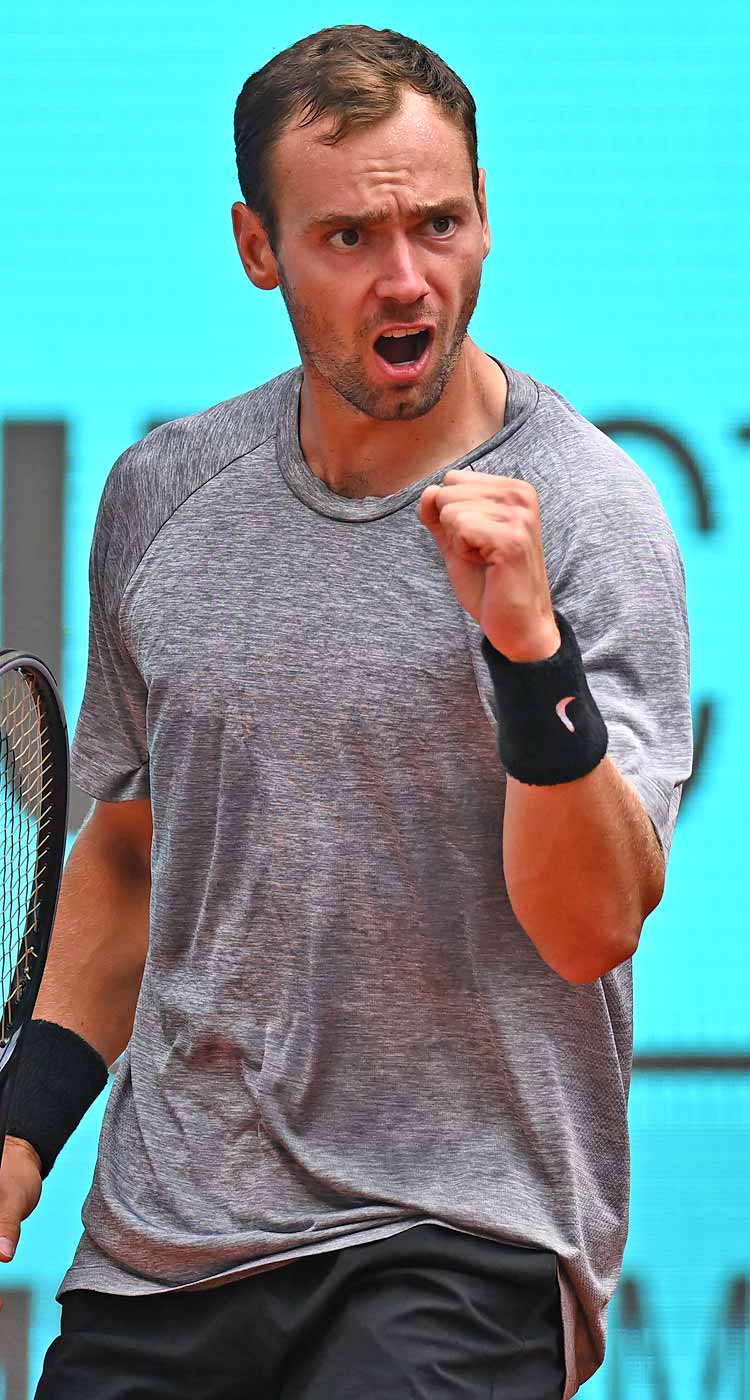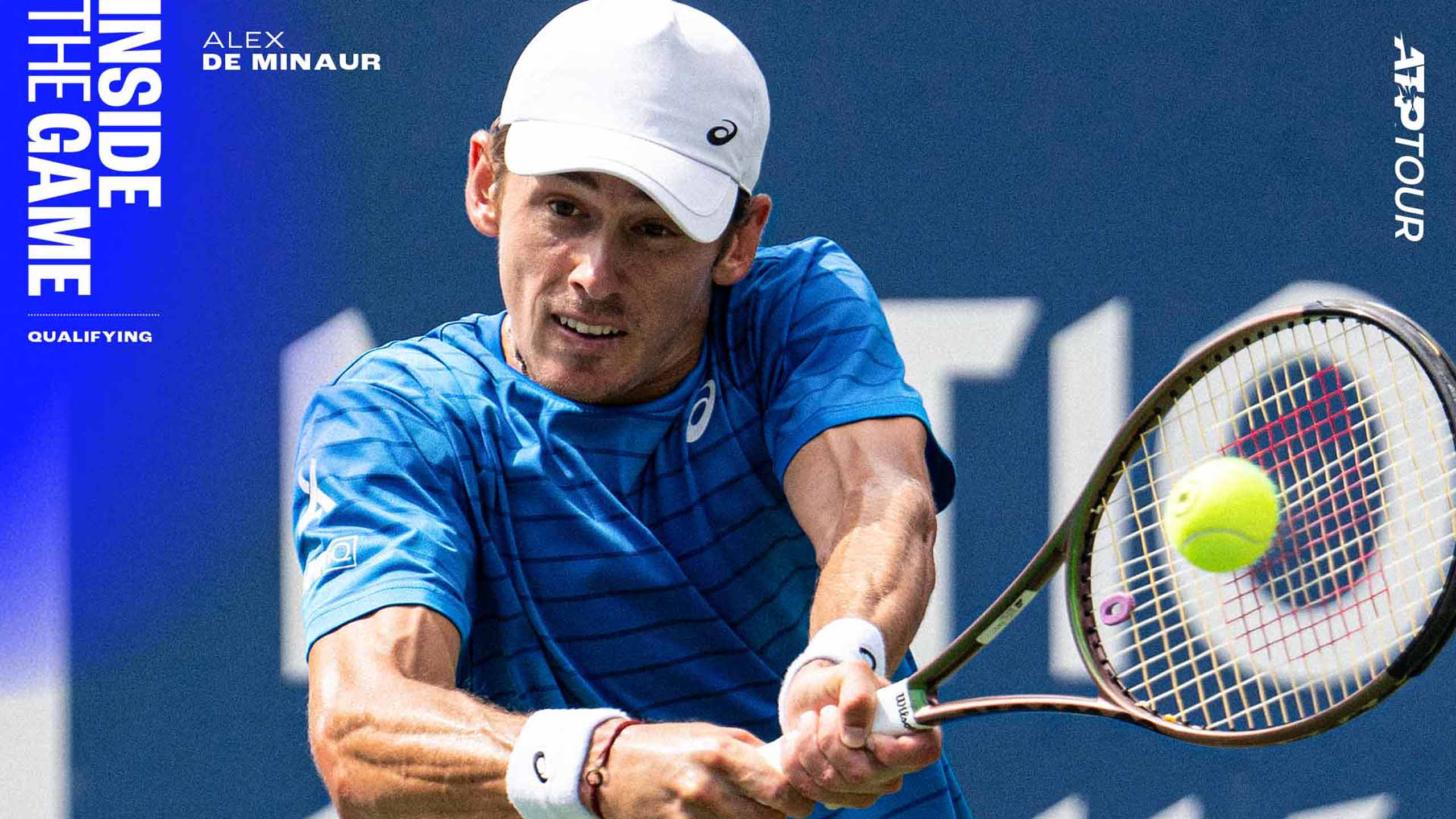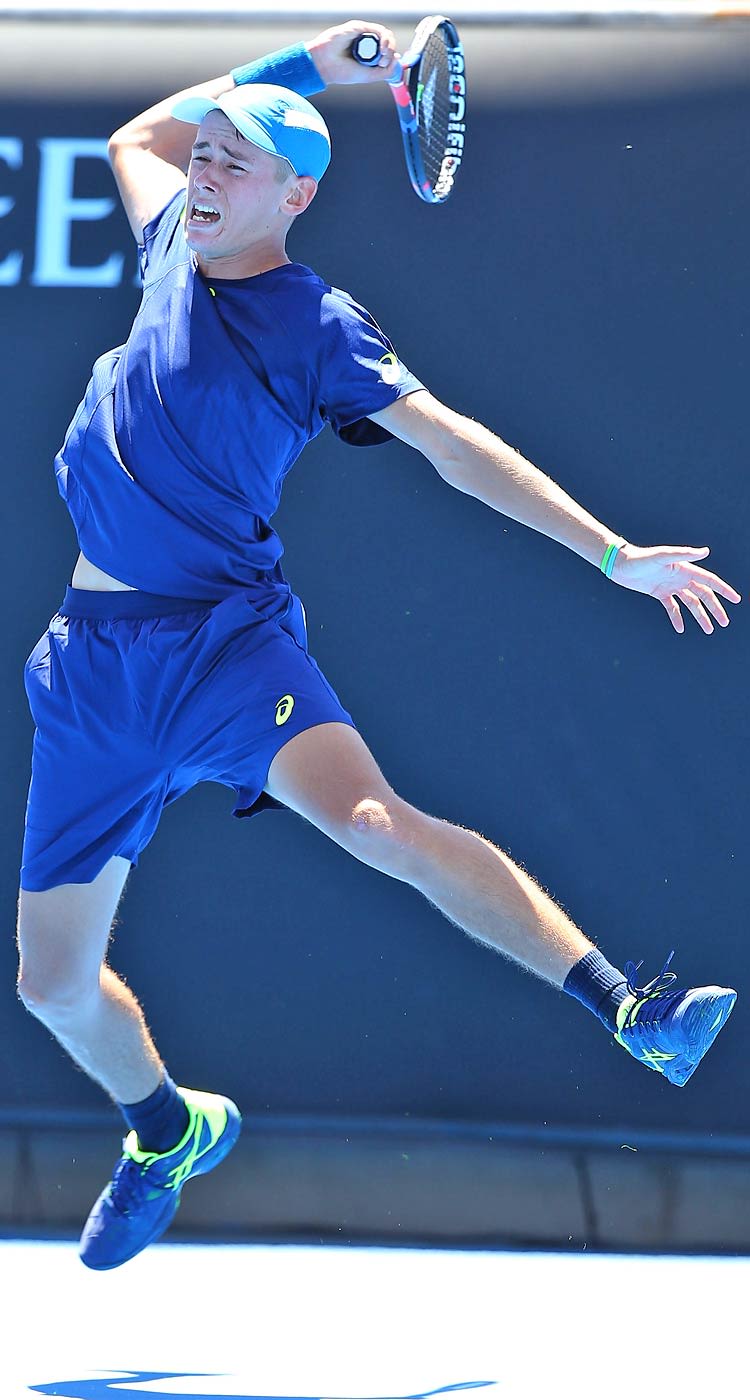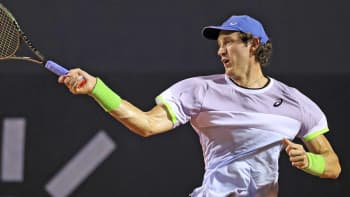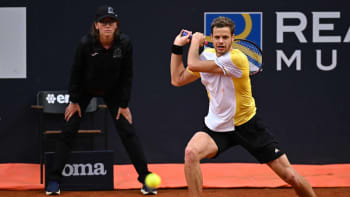'The Qualies'
A Gateway To Success On The ATP Tour
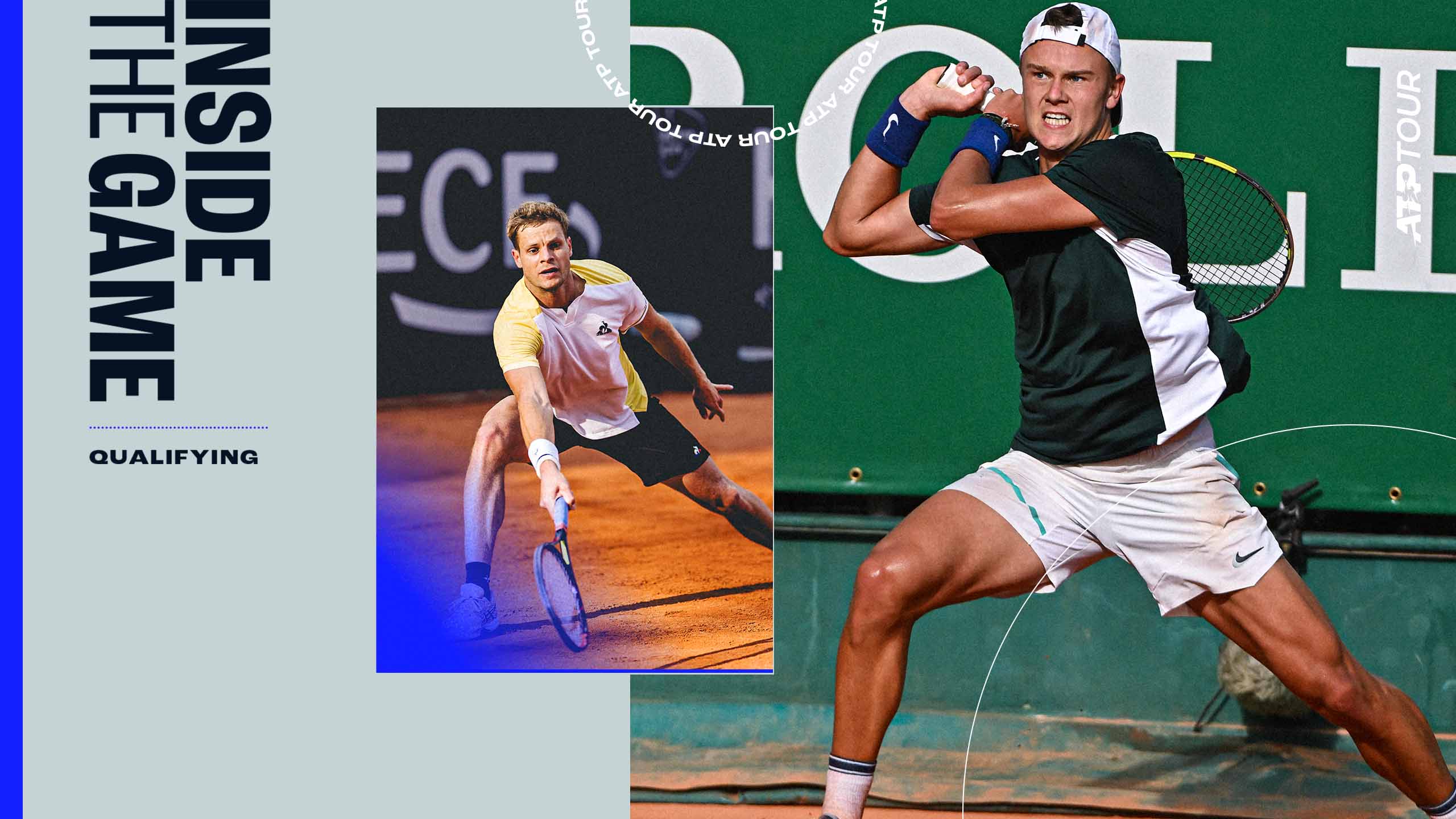
The Show Before The Show
An ATP Tour star's journey has to start somewhere.
Featuring an intriguing blend of battle-hardened pros seeking access to the greater ranking points and prize money on offer in the main draw, with fledgling young talents just starting their journey to the very top, qualifying is a unique part of tennis’ ecosystem.
Frequently navigating through 'qualies' is crucial for players to improve their Pepperstone ATP Ranking as they look to make the step up from the second-tier ATP Challenger Tour to become an ATP Tour regular. It therefore represents a ‘bridge’ between the two Tours, one that also often holds emotional and financial implications for a player’s career.
Before the main-draw action begins at an ATP Tour event, two or three rounds of qualifying are held to determine who claims the final few spots in the main draw. Players with a Pepperstone ATP Ranking that is not high enough to gain automatic entry to the main draw can enter, and those who win all their matches move on to the main event.
As part of the Inside The Game series, a host of ATP Tour stars provide an insight into the challenges, benefits and quirks of life as a qualifier.
Qualifier Roman Safiullin at the 2023 Mutua Madrid Open. Photo: Corinne Dubreuil/ATP Tour
Qualifier Roman Safiullin at the 2023 Mutua Madrid Open. Photo: Corinne Dubreuil/ATP Tour
Alex de Minaur in Toronto in 2023. Photo: Mike Lawrence/ATP Tour
Alex de Minaur in Toronto in 2023. Photo: Mike Lawrence/ATP Tour
'A Whole Different Ball Game'
Aussie star de Minaur recalls thrill of early qualifying success
Some may expect qualifying to be a lower-level warm-up for the main event at an ATP Tour tournament. That could not be further from the truth for those competing.
“For me it was a whole different ball game,” reflects Australian star Alex de Minaur on his maiden ATP Tour qualifying campaign as a 17-year-old in Brisbane in 2017. “First round, I had to play [Mikhail] Kukushkin, who at the time, I knew nothing about. Just that he was a veteran player with loads and loads of experience. You play a lot of Challenger Tour events here and there, but you can feel it in your gut it's something extra special when you're able to qualify for an ATP event.”
The Australian defeated World No. 89 Kukushkin and then fellow teenager Frances Tiafoe to reach the main draw that year in Brisbane. De Minaur has since risen to as high as World No. 12 and lifted seven ATP Tour trophies, but that does not mean he takes anything for granted nowadays when he takes on a qualifier.
“You’ve got qualifiers beating guys in the main draw without a problem, and they're bloody good players," said the 24-year-old. "So I think the qualifiers, if they can play their level, that's where they get their big break. If they can do well in one of these tournaments, or bigger tournaments, win a couple of matches, that's when they get a whole lot of points and from then on, they're able to play the main draws [automatically] at a lot of the events.”
"If I have to play someone now who's young or unknown, well, I know they're coming for me."
De Minaur's Brisbane qualifying rival Tiafoe has also gone on to become a member of the elite — the American broke the Top 10 of the Pepperstone ATP Rankings in June 2023. As Tiafoe and de Minaur have both shown, it is not uncommon for a once-unknown young talent competing in qualifying to go on to become one of the world’s top players.
“I played Tiafoe to qualify for my first ATP Tour event," said de Minaur. "If I have to play someone now who's young or unknown, well, I know they're coming for me, because I was in that position a couple of years ago as well."
A 17-year-old de Minaur at the 2017 Australian Open. Photo: Michael Dodge/Getty Images.
Photo: Mike Lawrence/ATP Tour
De Minaur celebrates a victory in Toronto in 2023. Photo: Mike Lawrence/ATP Tour
A 17-year-old Alex de Minaur at the 2017 Australian Open. Photo: Michael Dodge/Getty Images
Holger Rune at the 2022 Rolex Monte-Carlo Masters. Photo: Corinne Dubreuil/ATP Tour
Holger Rune at the 2022 Rolex Monte-Carlo Masters. Photo: Corinne Dubreuil/ATP Tour
Rune sends down a serve during his second match of a whirlwind Saturday in April 2022. Photo: Corinne Dubreuil/ATP Tour
Photo: Corinne Dubreuil/ATP Tour
Rune relaxes with his mum Aneke in Monte-Carlo after playing two matches in two different countries — on the same day. Photo: Corinne Dubreuil/ATP Tour
Rune relaxes with his mum Aneke in Monte-Carlo after playing two matches in two different countries — on the same day. Photo: Corinne Dubreuil/ATP Tour
Tough Turnarounds
Two matches, two countries in one day for Rune
Sometimes, the biggest challenge of life as a qualifier is getting to court on time.
At around lunchtime on Saturday, 9 April 2022, Holger Rune clinched victory in the final at an ATP Tour Challenger event in Sanremo, Italy. A morale-boosting triumph for the talented teenager, Rune’s next assignment was to compete in the qualifying draw at the prestigious Rolex Monte-Carlo Masters. The only problem? His first-round qualifying match against Moldova’s Radu Albot was scheduled for later that very afternoon, and Monte-Carlo lies approximately 40 kilometres west of Sanremo along the Mediterranean coast.
“It was a very intense day,” recalls Rune. “I knew before I played the final in Sanremo that I was signed in for the qualies in the afternoon in Monaco. It was actually more stressful the day before than on the day, because you knew the night before, ‘Okay I will play two matches tomorrow’. Two important matches.
“I actually didn't sleep very well, but I managed to get through and win the final [in Sanremo] and win the first match [in Monte-Carlo qualifying]. It was so busy, but luckily, I had a quick massage between the matches just to get ready and I was very relaxed in the second match.”
It was a classic example of the sometimes-hectic nature of professional tennis: Qualifying rounds usually take place on the Saturday and Sunday before main-draw play, when the previous week's events are still ongoing. Rune nonetheless has fond memories of the dash by car from Italy over the border into France and on to the historic Monte-Carlo Country Club.
“I was with my coach and my mum,” said the Dane. “I think we were all very quiet actually, because we were super tired because it was a long week in Sanremo. In general we were just happy because it's a good moment coming from a title, going to Monaco, which is one of the best tournaments in the world. So everything was good, honestly. We were happy.”
"Even though you're a qualifier, you are still there with all the players and all the great facilities. So you feel more like an ATP Tour player."
Like de Minaur, Rune’s first ATP Tour qualifying success came when he was 17. The Dane, now a Top 10 player with four ATP Tour titles, battled his way to the main draw in Santiago in 2021. He remembers the impact that feat — as well as his other experiences as a qualifier — had on his self-belief when he was an impressionable teen cutting his teeth on Tour.
“It feels different [as a qualifier] because suddenly you get to play the big events,” Rune said. “Even though you're a qualifier, you are still there with all the players and [using] all the great facilities. So you kind of feel more like an ATP player, and that's great. That gives you extra motivation and confidence to do better. And from there on, it's a journey, you know. It's a long journey to the top.”
Nicolas Jarry in action at Wimbledon in 2023. Photo: Corinne Dubreuil/ATP Tour
Photo: Corinne Dubreuil/ATP Tour
No Pain, No Gain
Jarry's contrasting tales reflect the uncertainty of qualifying
Even if playing two matches in a day is a rare occurrence, it is not unusual for a player to step on court to compete in qualifying just hours after arriving in town. Unlike Rune’s Monte-Carlo moment, Nicolas Jarry’s sprint from ‘s-Hertogenbosch in The Netherlands to The Queen’s Club in London in 2019 did not have a happy ending. The Chilean’s story is a demonstration of how up and down life as a qualifier can be.
“I lost against [Richard] Gasquet in the quarter-finals very late in the day [in ‘s-Hertogenbosch] and I had to just shower and buy plane tickets for the next day at 8 a.m,” remembers Jarry. “I arrived in London at 10 a.m., went straight to the tennis club with all the bags and everything, warmed up a little bit and played my first qualifying match at 3 or 4 p.m. I ended up losing 7-6 in the third. Many things like that happen often.”
"I think everybody on Tour has a very good fitness level, so two qualifying matches don’t really affect them."
Disappointments such as Jarry’s trip to London make capitalising on qualifying successes even more important. Once a player qualifies, they have earned the chance to make a dent in the main draw, where more substantial points and prize money are on offer. Having already acclimatised to the conditions and found a winning groove, can playing qualifying actually help a player once they reach that stage?
“I think nowadays it does help,” said Jarry. “If it's an ATP event where qualifying is only two matches, it helps. If it's a Grand Slam, that's three qualifying matches, then not so much. But I think everybody on Tour has a very good fitness level, so two matches don’t really affect them. They are already in rhythm, they already know the conditions, they already have more confidence because they won two matches. If it's a player with a good mentality, it's better for them to have that advantage.”
There is a flip side to the extra matches, of course, especially if a qualifier ends up making it deep into a main draw. At an ATP 500 event in Rio de Janeiro in February, Jarry reached the semi-finals as a qualifier and his run was only halted by defending champion Carlos Alcaraz in three sets. By then, the physical toll of playing his sixth match on the Rio clay in the space of eight days had started to impact him.
“Yeah, it did for me. It was already the sixth match and in Rio the conditions are very, very tough, very humid, and very hot. Over 30 degrees.” recalls the Chilean. “So, it got to me a little bit. But at least for the first round and the second round, it's much better [to have played qualifying].”"
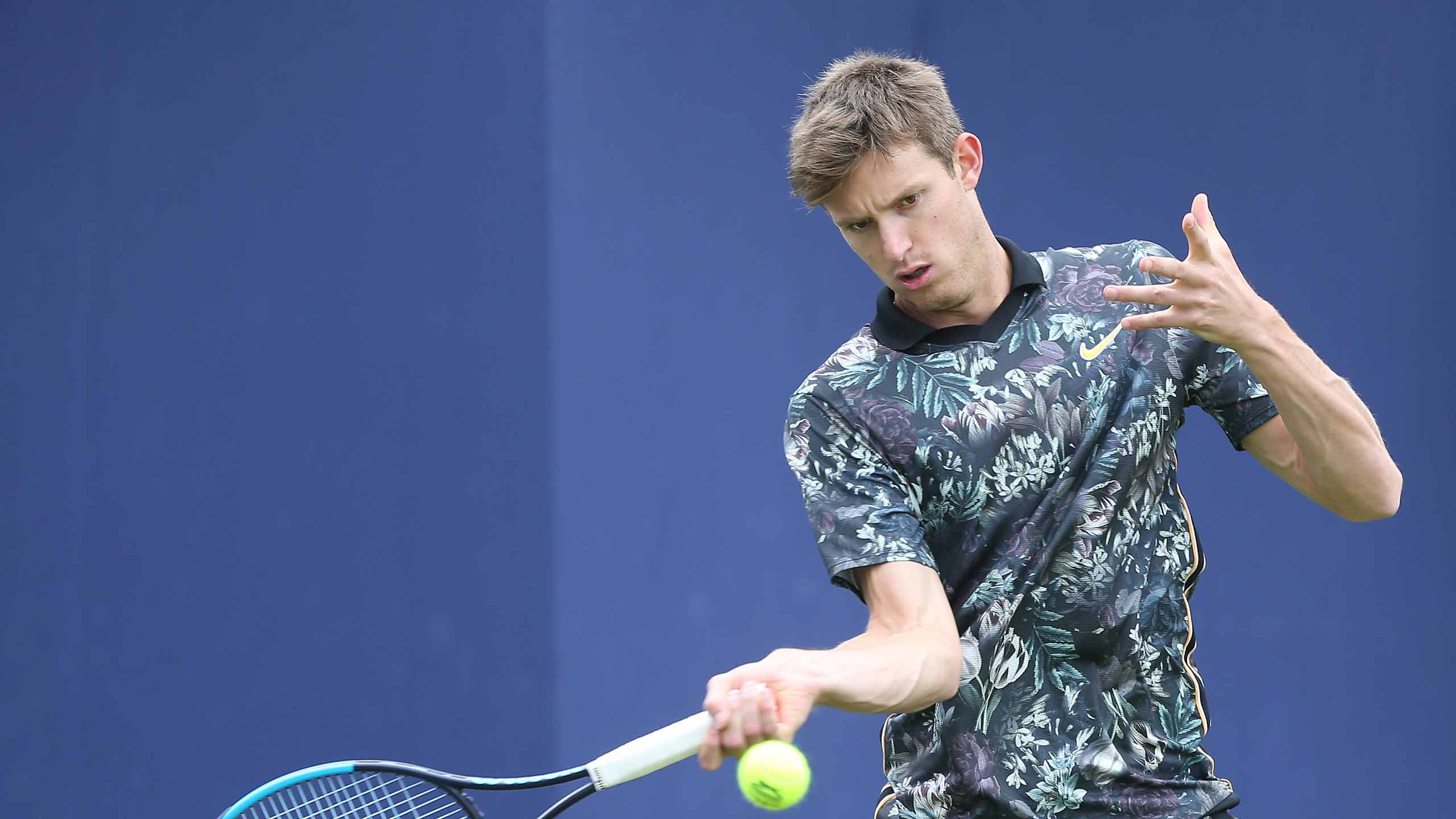
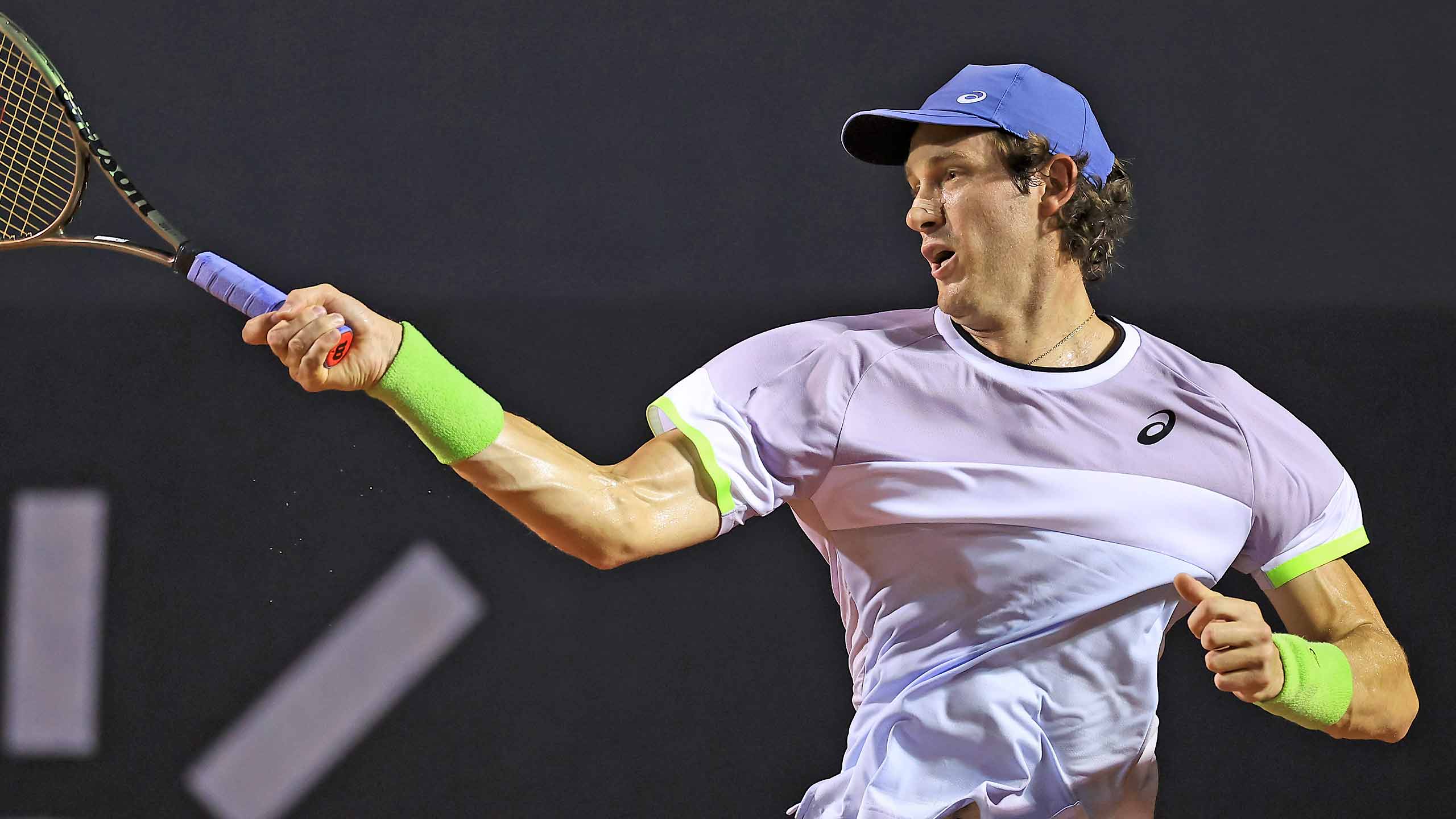
Matteo Arnaldi celebrates the first Top 10 win of his career against Casper Ruud in Madrid. Photo: Clive Brunskill/Getty Images.
Matteo Arnaldi celebrates beating Casper Ruud in Madrid in 2023. Photo: Clive Brunskill/Getty Images.
Arnaldi during his successful qualifying campaign at Wimbledon in 2023. Photo: Ben Stansall/AFP via Getty Images
Photo: Clive Brunskill/Getty Images
Arnaldi reached the second round as a qualifier in Toronto in August. Photo: Mike Lawrence/ATP Tour
Arnaldi in Toronto in August. Photo: Mike Lawrence/ATP Tour
Baptism Of Fire
Qualifying a tough school for upcoming talents
Matteo Arnaldi is another example of a player who has capitalised on qualifying momentum in the 2023 season. The 22-year-old Italian reached the main draw in Madrid in April and then defeated World No. 4 Casper Ruud en route to the third round at the ATP Masters 1000 tournament. That achievement came just two months after his first attempt at qualifying for an ATP Tour event.
“It's a totally different Tour and world,” said Arnaldi of the step up from the ATP Challenger Tour to ATP Tour qualifying. “The first time I felt so much pressure, and I think they are also completely different matches. Sometimes the players that you play against in qualies are the same as in Challengers, but it’s a totally different tournament, with different facilities you have at the tournament. It was a bit tough maybe to understand how to do well, but now I think I'm doing great.”
As a newcomer to the Tour who regularly competes in qualifying, how does Arnaldi approach an event?
“I think first about qualifying, because it's a completely different draw after,” said the Italian. “The main thing also is the hotel, because you have a lot of nights at the hotel, you have everything paid, you can stay all the week maybe also to practise [if you reach the main draw]. Usually if you lose in qualies, maybe you go home because it's a lot of days [before] the next tournament. I'm from Italy, so if I’m in Europe, maybe I go back [home]."
"The nights in the hotel are always something that help when you are not rich and not able to pay a lot."
Arnaldi’s mention of hotel rooms is another, perhaps lesser-known aspect of life as a qualifier. Each tournament offers players a room in a tournament hotel while they compete in qualifying, and that all-expenses-paid stay can be extended by reaching the main draw. What may seem a token gesture to some can in fact be crucial for players looking to make ends meet across an 11-month season during which accommodation costs add up quickly.
"I didn't have much money when I was younger. My family, all of us," recalls Arnaldi. "So sometimes I think about it, with the nights [in the hotel], it is always something that [helps] when you are not rich and not able to pay a lot. When I was a junior, I also travelled a lot alone because I couldn't afford a coach.”
The more you qualify, the more main draws you reach, the more prize money you earn. It is a tough world in which to operate, but one which offers high rewards for success. Arnaldi can attest to that fact — he broke the Top 100 of the Pepperstone ATP Rankings with his Madrid run, for which he also earned €48,835 prize money.
“Sometimes it comes in my mind, but maybe now I started to earn a bit more, I just try to go on court and think about the match, think about what I have to do and do my thing,” said the Italian, who reached as high as World No. 42 in early October. “I try to do my best and then it will come later for sure. If I don't get the win this time, I will get the win another time.”
Jan-Lennard Struff at the 2023 Rolex Monte-Carlo Masters. Photo: Corinne Dubreuil/ATP Tour
John Isner. Photo by Matthew Stockman/Getty Images
Struff and Carlos Alcaraz embrace after the Spaniard's final win in Madrid in May. Photo: Clive Brunskill/Getty Images
Photo: Corinne Dubreuil/ATP Tour
Struff in action in Miami in March 2023. Photo credit: Peter Staples/ATP Tour
Struff and Carlos Alcaraz in Madrid. Photo: Clive Brunskill/Getty Images
Bouncing Back
Struff's qualifying streak triggered charge back up rankings
It isn’t just for up-and-coming talents that qualifying wins can spur a change in fortunes. After a tough run of injuries, Germany’s Jan-Lennard Struff has rejuvenated his career off the back of a string of qualifying successes.
The 33-year-old was World No. 167 in early January but racked up a 10-1 record in qualifying matches across the first half of 2023. He built on those victories in main draws, too, reaching the quarter-finals in Monte-Carlo and the final in Madrid to rise to a career-high No. 21 in June.
“You don't want to lose in qualifying, you don't want to lose first round in the main draw, you don't want to lose at all, but sometimes it's a bit different,” Struff told ATPTour.com after his Madrid run. “I lost matches in qualifying in my career. I just somehow got a rhythm winning matches [this year], and I’m very happy with that. I didn't know actually that it was 10-1, so I’m pretty happy, and in qualifying there are so many strong players as well.
“It builds up a lot of confidence. If you qualify, come into the main draw, you’ve played some matches, it feels much better. You feel kind of in rhythm.”
Having been a consistent presence in the Top 100 for much of his career prior to his injuries, Struff was often one of the most experienced and established players in the qualifying draws he entered this year. While crucial for his own return to the top of the game, the German recognises the extra significance qualifying matches hold for his rivals who may not yet have made their mark on the upper echelons of professional tennis — not least because he was once in their shoes.
“The most important qualification for me was Roland Garros in 2013, when I beat [Teymuraz] Gabashvili,” recalled Struff. “It was my first time qualifying for a Grand Slam, which felt really, really good. That was huge for me. After that I qualified for Wimbledon, and it was big for me. I think a lot of players have these qualifying moments which make them believe they can do it, go further, and go past this stage. It makes a lot of confidence and belief, I would say.”
"I feel like the quality of players and the level in qualifying raised so much in the past few years. It’s so good."
Now his ranking is again high enough to gain automatic entry to most main draws, it is Struff who sometimes finds himself in the sights of in-form qualifiers chasing an upset. He does not underestimate anyone who has played their way into the draw, particularly when it comes to his opening match at an event.
“Sometimes It's tough because they have some rhythm,” said Struff of taking on a qualifer. “It depends. Sometimes on grass, for example, if they played a first match, they have some matches in stock already. It could be good, it could be bad. Sometimes it's good not to get a main-draw player straight away, like a seeded player.
“Some players are very dangerous, upcoming players who are playing qualifying. I feel like the quality of players and the level, like in Challengers as well, raised so much in the past few years. It’s so good. It is sometimes very, very tough.”
Yannick Hanfmann tracks down a wide ball in Hamburg in July. Photo: Alexander Scheuber/Getty Images for MatchMaker
Photo: Alex Scheuber/Getty Images for MatchMaker
Qualifying King
Hanfmann has earned spot in seven main draws in 2023
The financial stakes of qualifying may be high, but it is a sporting motivation that drives most players once they hit the court. As Yannick Hanfmann well knows, strong form in 'qualies' can act as a catalyst for a completely different career trajectory.
The German has qualified for a Tour-leading seven main draws so far in 2023, successes which helped him break the Top 50 of the Pepperstone ATP Rankings for the first time in July at the age of 31.
“When I play to qualify, I just want to be in the main draw,” says Hanfmann. “I just want to get there. It's not too much about money. I don't think about that. In Grand Slams, obviously, the satisfaction of getting to the main stage with the prize money is much bigger... But the main priority is to get into the main draw, to play with the big guys, and that's the pressure.”
Germany’s Hanfmann acknowledges that the allure of the ‘big time’ can be hard to ignore when trying to secure qualification, especially at the four Grand Slam events: the Australian Open, Roland Garros, Wimbledon, and the US Open.
“I think the qualifying final match, there's maybe a little bit of extra pressure, because you want to get into the main draw, and I think I've handled that this year probably pretty well.” says Hanfmann. “I think the height of qualifying is probably Wimbledon, just because you play in Roehampton, and you're trying to make it to the [All England Club]. I think there's this extra will to make it to the to the main draw.”
"The main priority is to get into the main draw, to play with the big guys, and that's the pressure."
As is so often the case in the fast-paced world of tennis, there is little time to relish a success. Hanfmann speaks of the conflicting emotions that come with reaching the main draw.
“The satisfaction is definitely there, but it's short-lived, because then once you're there, you want to keep going,” said Hanfmann, who reached an ATP Masters 1000 quarter-final as a qualifier in Rome in May. “I think what helped me in the past is to get into a match rhythm and go far into the tournament because I've shown that when I get my matches, that I'm actually dangerous. It's nice to have that, to get into a rhythm and then just be dangerous.”
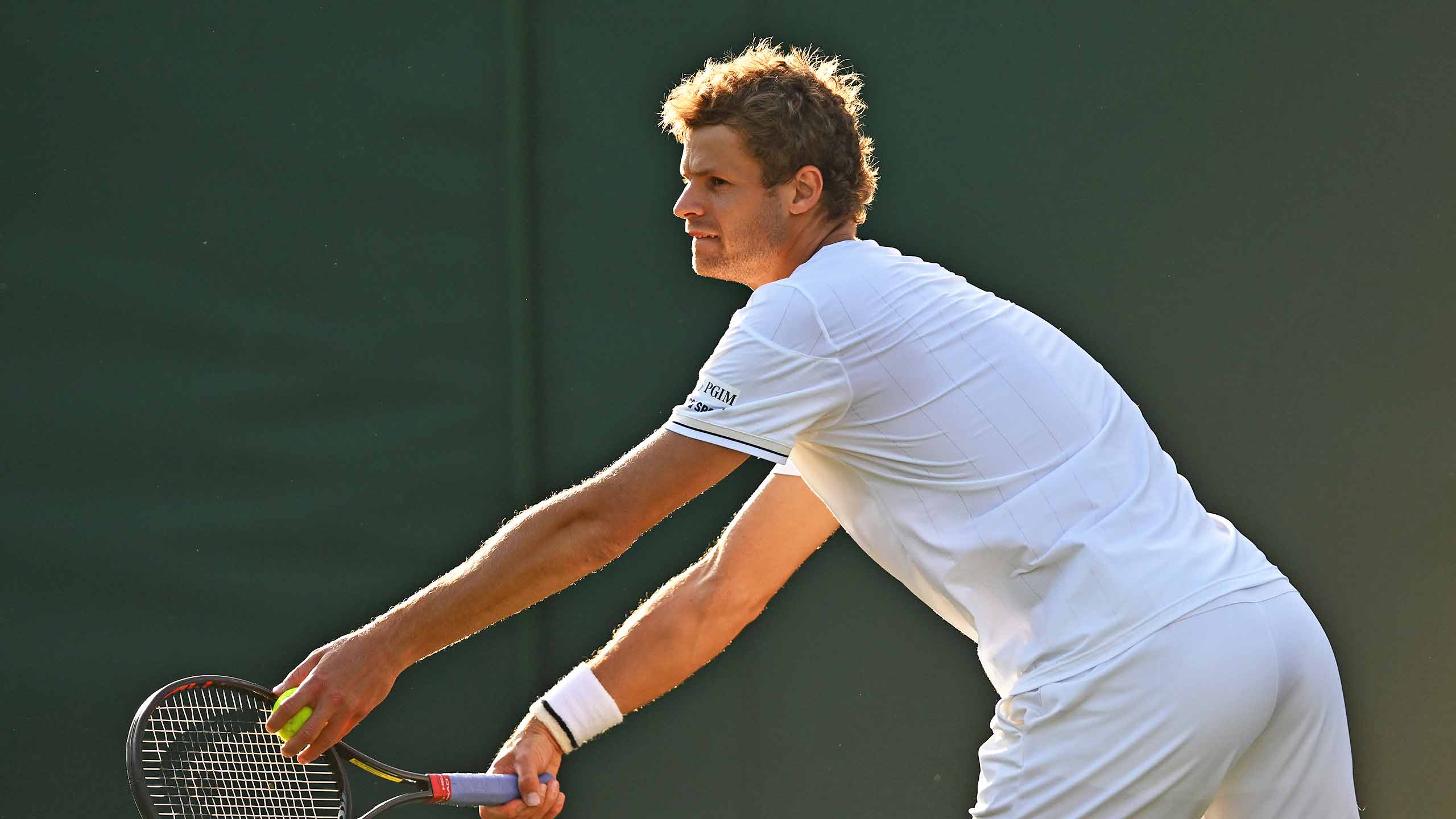
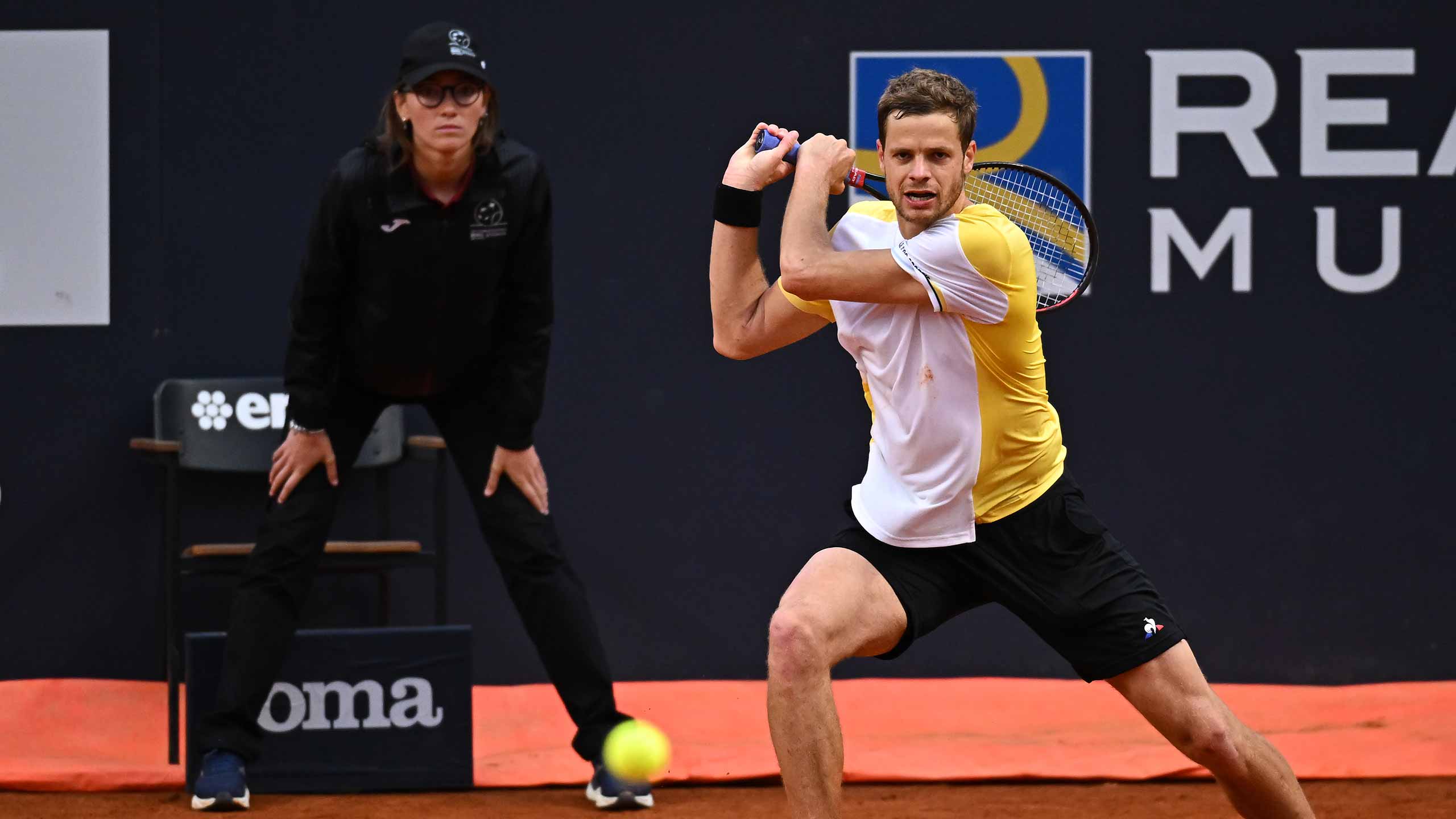
Gregoire Barrere in Rome, 2023. Photo: Corinne Dubreuil/ATP Tour
Gregoire Barrere in Rome, 2023. Photo: Corinne Dubreuil/ATP Tour
Quirks Of Qualifying
Instant rematches and logistical upheaval are unique 'rewards' for qualies success
The knockout format of almost all ATP Tour events makes it impossible for the majority of players to play the same player twice. Indeed, it is a quirk of tennis that is only ever experienced by qualifiers.
A player who falls during qualifying still has hope of reaching the main draw as a ‘lucky loser’. This term refers to a player who lost in qualifying but is added the main draw as a replacement following another player’s withdrawal from the main draw, typically due to illness or injury.
This creates the potential of a player winning their final qualifying match and then being drawn against the same opponent (competing as a lucky loser) in the main draw. Frenchman Gregoire Barrere acknowledges the frustration a player can experience if they qualify successfully only to lose in the main draw to the opponent they had just beaten.
“Most of the time [the qualifier] loses in the first round against the lucky loser,” joked Barrere. “My friend Lucas Pouille almost had that not long ago at Roland Garros. Arthur Fils had that in Bercy. He won the match in qualifying against [Fabio] Fognini and then lost in the first round to him. So sometimes some tricky things happen.”
If they qualify successfully, a qualifier may be obliged to pack their bags and move to a hotel reserved for main-draw players.
There are also potential logistical differences for qualifiers. A player might like to settle into a hotel room, make themselves feel at home quickly and focus solely on preparations for their next match. If they qualify successfully, however, they may be obliged to pack their bags and move to different accommodation reserved for main-draw players.
For Barrere, that is a minor inconvenience in the big scheme of things, and he believes qualifiers are nonetheless made to feel a true part of ATP Tour events.
“Most of the time, I think it's not the same hotel, but it's the only thing that really changes between the qualies and the main draw,” he said. “You feel like you are a player. It's like a main-draw player, almost, at every tournament now. It's a good thing.”
They don’t only feel like they are part of the main draw. They play like it, too.
“I think now, everyone is playing good,” said Barrere. “Before you used to say, ‘Well I’m playing a qualifier, it’s a good draw’. Now you see a lot of qualifiers go to the quarter-finals or semi-finals or final [in main draws]. Even at a Grand Slam some players are doing that now.”
Barrere in Toronto, August 2023. Photo: Mike Lawrence/ATP Tour
Photo: Corinne Dubreuil/ATP Tour
Barrere competes at Wimbledon in 2021 after coming through qualifying. Photo: Corinne Dubreuil/ATP Tour
Barrere has qualified three times at Wimbledon. Photo: Corinne Dubreuil/ATP Tour
Roman Safiullin at the 2023 Winston-Salem Open. Photo: Grant Halverson/Getty Images
Roman Safiullin at the 2023 Winston-Salem Open. Photo: Grant Halverson/Getty Images
Safiullin celebrates beating Stefanos Tsitsipas in Marseille in 2022. Photo: Nicolas Tucat/AFP via Getty Images
Photo: Grant Halverson/Getty Images
Safiullin in action in Cincinnati, August 2023. Photo: Peter Staples/ATP Tour
Lloyd Harris at WImbledon. Photo: Matthias Hangst/Getty Images
Sliding Doors
A fork in the road to start each week on Tour
The start of a big breakthrough, or another tournament over before it has even begun?
Roman Safiullin enjoyed his breakout run on the ATP Tour as a qualifier in February 2022 at an ATP 250 event in Marseille, where he beat Stefanos Tsitsipas in the quarter-finals before pushing another Top 10 opponent, Felix Auger-Aliassime, close in the last four.
Safiullin views every match he plays as integral to his career, whether it is a qualifying round in Marseille with few spectators or a quarter-final on a packed Court 1 at Wimbledon — where he reached the last eight this year before falling to Jannik Sinner. This approach helps him maintain his focus, regardless of his surroundings.
“Even if I passed the qualies, this is not the end goal,” says Safiullin. “Of course, I want to get more and more wins in the main draw. When I’m on court, I don't think about the money or the points, I just come in and try to beat my opponent on the day. The same in the next round, when you get even more money and more points. But I don’t work like this. I just trying to be focused on how to beat the guy, and that’s it.”
"I was on my way to the beach and they called me and said, ‘Listen, you’ve got to come and play in one hour’."
In the unpredictable world of the ATP Tour, of course, things don’t always run so smoothly. The list of of players entering a tournament often chops and changes at the last minute for a myriad of reasons ranging from injuries to travel delays. That led to a whirlwind day in July for Lloyd Harris, who had flown to Mallorca to enter qualifying at an ATP 250 event only to find his ranking meant he missed out on the draw by just two spots.
Hoping to douse his disappointment under the Balaeric sun, the South African was headed to the beach when his phone rang — two players had withdrawn from qualifying, and he was in.
“It was very funny, because obviously the draw came out and I was second alternate, so I saw I didn’t make it. So I thought my chances were maybe three per cent, five per cent,” said Harris. “So I was on my way to the beach and they called me and said, ‘Listen, you’ve got to come and play in one hour’."
Harris made it to his match on time, qualified successfully and then charged through the main draw to the semi-finals before narrowly falling to American Christopher Eubanks. A successful week on the Mallorca grass had materialised out of nothing, giving Harris a feeling that a host of hopefuls chase every week as they step out to play qualifiers on the ATP Tour.
“It was a bit of a surprise,” said Harris after his quarter-final victory in Spain. “But now I’m here, so I’m very happy with the situation.”
Lloyd Harris takes on Roger Federer on Centre Court at WImbledon in 2019. Photo: Matthias Hangst/Getty Images
Lloyd Harris takes on Roger Federer on Centre Court at WImbledon in 2019. Photo: Matthias Hangst/Getty Images




